Let go of the assumption that most of your audience doesn’t wish to have their data tracked. Salesforce conducted a study that stated that 79% of the DTC audience wishes for marketers to send them a personalized experience and offers and, for that, they don’t mind their purchase history being tracked. Now that’s A LOT of customers. So, Why Should You Collect Data?
Customer data is crucial in understanding your audience’s behavior—buyer personas, basic details, shopping habits, online behavior, and more. This can help you develop targeted ads and experiences that can help your customers have a better time when interacting with your eCommerce store. This information can also be helpful when curating personalized offers and discounts for your customers as well as running targeted ad campaigns. You could even use the insights when shaping future products, solutions, and/or services for your customers to provide them with a more customer-centric experience.
Let’s say your brand is facing a slow month at the store and you’re looking for ways to generate more traffic to your eCommerce website. You could pull out a detailed report on who shopped from your store at the same time over the last couple of years and segment them accordingly. Perhaps reaching out to them with a few great product images, a limited period offer, or a special discount can have them coming back to you. Sounds great, doesn’t it? Collecting data isn’t as shady as it may seem anymore. You can give your customers a seamless experience online while extracting the required information.
Here are some of the most common ways DTC brands do so.
💻 Website
You can start data collection as soon as someone drops on your website! Consider plugging in a chatbox or pop-ups that prompt them to submit some basic information such as name & email address for an offer. Actively survey the data collected on Google Analytics or other third-party analytics tools to see who your online visitors are and how you can better cater to their needs.
💳 Online Transactions
With each transaction a customer makes, you can collect their transactional data. This records a history including the point-of-sale, customer journey, and more. Furthermore, you could track the coupon code they used, which platform redirected them to your website, and what their general interaction with the website looks like.
📝 Surveys
Surveys on the website, on third-party websites, or sent to the customers via their email—all bring you a lot of information that can be useful. You could send these surveys post-purchase or post-purchase returns to collect more information on their highlights and frustrations when shopping at your store.
📱 Social Media
Social media channels are a great way to legally collect user data and segment it according to your needs. With users constantly interacting with you—liking and commenting on your posts, responding to your questions, and sharing your content, you can learn who your potential customers are. Use social media features for engagement such as Quizzes, Questions, Polls, Sliders, and personal DMs. Hosting giveaways and contests here would be a great idea! This would have you not only attract a more relevant audience but also give you a chance to gather more personal data.
🎁 Loyalty Programs
If a customer is in the process of signing up for a loyalty program, they’ve already made up their mind! With all the incentives in mind, your customers will surely be willing to give away some additional information that you request during the process. Thankfully, many automated systems have built-in customer management and segmentation systems to be integrated into your brand’s original process seamlessly. This allows you to easily get real-time reports to understand your customers better. If you wish to run more effective campaigns and attract a relevant audience, consider investing in a tool early on that can help you do so easily.










